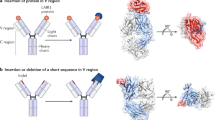Abstract
Sir Macfarlane Burnet has been one of the twentieth century’s outstanding biologists. In the years 1941–1956, Burnet focused his effort on the elaboration of a theory of antibody synthesis, the clonal selection theory, capable of bridging the gap between physiological findings, such as the kinetics of antibody production, self-tolerance and immunological memory on the one hand, and the newest ideas on synthesis of proteins, on the other. At the time of writing the clonal selection theory, Burnet was 57 years old and the Director of the Water and Eliza Hall Institute in Melbourne, Australia.

Similar content being viewed by others
References
Lederberg J (1988) Ontogeny of the clonal selection theory of antibody formation. Reflections on Darwin and Ehrlich. Ann N Y Acad Sci 546:175–187
Forsdyke DR (1995) The origins of the clonal selection theory of immunity as a case study for evaluation in science. FASEB J 9:164–166
Silverstein AM (2002) The clonal selection theory: what it really is and why modern challenges are misplaced. Nat Immunol 3:793–796
Editorial (2007) Sir Frank Macfarlane Burnet, 1899–1985. Nat Immunol 8:1009
Nossal GJV (2007) One cell-one antibody: prelude and aftermath. Nat Immunol 8:1015–1017
Hodgkin PD, Heath WR, Baxter AG (2007) The clonal selection theory: 50 years since the revolution. Nat Immunol 8:1019–1023
Cohn M, Mitchison NA, Paul WE et al (2007) Reflections on the clonal-selection theory. Nat Immunol 7:823–830
Ada G (2008) The enunciation and impact of Macfarlane Burnet’s clonal selection theory of acquired immunity. Immunol Cell Biol 86:116–118
Ribatti D (2006) The fundamental contribution of Robert A. Good to the discovery of the crucial role of thymus in mammalian immunity. Immunology 119:291–295
Ribatti D, Crivellato E, Vacca A (2006) Miller’s seminal studies on the role of thymus in immunity. Clin Exp Immunol 144:371–375
Ribatti D, Crivellato E, Vacca A (2006) The contribution of Bruce Glick to the definition of the role played by the bursa of Fabricius in the development of the B cell lineage. Clin Exp Immunol 145:1–4
Breinl F, Haurowitz F (1930) Chemische Untersuchung des Prazipitates aus Hamoglobin and Anti-Hamoglobin-Serum and Bemerkungen ber die Natur der Antikorper. Z Phyisiol Chem 192:45–55
Mudd S (1932) A hypothetical mechanism of antibody formation. J Immunol 23:423–434
Pauling L (1940) A theory of the structure and process of formation of antibodies. J Am Chem Soc 62:2643–2657
Burnet FM, Freeman M, Jackson AV, Lush D (1941) The production of antibodies: a review and theoretical discussion. Monograph of the Walter and Eliza Hall Institute of Research in Pathology and Medicine, No 1. Macmillan, Melbourne
Burnet FM, Fenner F (1949) The production of antibodies, 2nd edn. Monograph of the Walter and Eliza Hall Institute, Macmillan, Melbourne
Burnet FM (1953) Natural history of infectious diseases. Cambridge University Press, Cambridge
Burnet FM (1956) Enzyme, antigen and virus. Cambridge University Press, Cambridge
Ehrlich P (1900) On the immunity with special reference to cell life. Proc R Soc Lond 66:424–448
Jerne NK (1955) The natural selection theory of antibody formation. Proc Natl Acad Sci USA 41:849–857
Talmage DW (1957) Allergy and immunology. Ann Rev Med 8:239–256
Burnet FM (1957) A modification of Jerne’s theory of antibody production using the concept of clonal selection. Aust J Sci 20:67–69
Burnet FM (1959) The clonal selection theory of acquired immunity. Cambridge University Press, Cambridge
Talmage DH (1959) Immunological specificity: unique combinations of selected natural globulins provide an alternative to the classical concept. Science 129:1643–1648
Nossal GJV, Lederberg J (1958) Antibody production by single cells. Nature 181:1419–1420
Nossal GJV (1960) Ph.D. thesis. University of Sidney, Sidney
White RG (1958) Antibody production by single cells. Nature 182:1383–1384
Attardi G, Cohn M, Horibata K, Lennox ES (1958) On the analysis of antibody synthesis at cellular level. Bacteriol Rev 23:213–223
Jerne NK, Nordin AA (1963) Plaque formation in agar by single antibody-producing cells. Science 140:405
Palyfair JHL, Papermaster BW, Cole LJ (1965) Focal antibody production by transferred spleen cells in irradiated mice. Science 149:998–1000
Raff MC, Feldman M, de Petris S (1973) Monospecificity of bone marrow derived lymphocytes. J Exp Med 137:1024–1030
Kohler G, Milstein C (1975) Derivation of specific antibody-producing tissue culture and tumor lines by cell fusion. Eur J Immunol 6:511–519
Burnet FM (1967) The impact on ideas of immunology. Cold Spring Harb Symp Quant Biol 32:1–8
Jerne NK (1967) Waiting for the end: a summary. Cold Spring Harb Symp Quant Biol 32:591
Acknowledgments
This work was supported by grants from MIUR (PRIN 2007), Rome and Fondazione Cassa di Risparmio di Puglia, Bari, Italy.
Conflict of interest statement
The author declares that he has no conflict of interest related to the publication of this manuscript.
Author information
Authors and Affiliations
Corresponding author
Rights and permissions
About this article
Cite this article
Ribatti, D. Sir Frank Macfarlane Burnet and the clonal selection theory of antibody formation. Clin Exp Med 9, 253–258 (2009). https://doi.org/10.1007/s10238-009-0048-y
Received:
Accepted:
Published:
Issue Date:
DOI: https://doi.org/10.1007/s10238-009-0048-y




